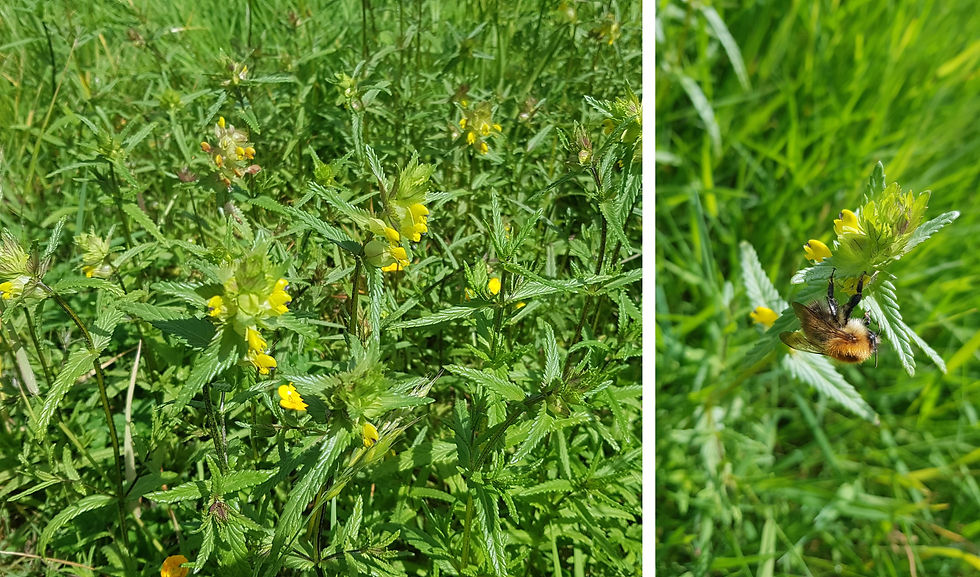Harvesting wild flower seed
- Alistair

- Aug 13, 2022
- 4 min read
Updated: Aug 24, 2022
As part of the effort to get nature back more rapidly than it might if left to its own devices, I have been trying to encourage wild flowers in the most “improved” top fields at Cefn Garthenor. These fields are well drained and have been fertilised over the years, as well as re-seeded with rye grass, giving them the monotone, green appearance we associate with good farm land. In order to give wild flowers a chance against the rye grass we need to remove nutrients and allow challengers in. Mowing and removing the grass has this effect, while leaving wide margins by the hedges (where there is the most non grass life, as tasty wild flowers were best protected from the sheep) allows competitors to the rye to creep out.
Late July saw the third mowing and baling of hay since the project began last year. That means probably around 500 large bales have been removed from the these 14 or so fields, hopefully taking a fair bit of nutrition with them. Most of this has been used (or will be used) to feed my neighbour Robert’s stock. We also kickstarted the wild flower growth by sowing one field with seed from the Welsh Botanic Gardens last December. This field has done well and grown a decent amount of yellow rattle, a wild flower with the added advantage of being a parasite to grasses, feeding off the nutrients in their root systems.

There was previously no yellow rattle on the land, so I’m keen to allow it to spread. Wild flower seed is expensive at around £100 per kilo and you need a good 8 kilos to do a small field. So, harvesting some seed and then sowing it elsewhere might make some sense.

I have avoided buying kit that is easily hired from neighbours and contractors. There are lots of tractors, mowers, balers, bale wrappers etc available in the area. However, seed harvesters are not so common, so I decided to buy one. The demand for them is not great and comes from small scale operators. A company called Logic has developed the machine I bought (full details at Seed Harvester MSH420 from Logic (logictoday.co.uk)). Essentially it has a motor which powers a 120cm / 4’0 with rotary brush. This is enclosed in a metal case (rather like a rotary lawn mower) and is pulled across the seed heads, removing them and throwing them into a hopper. The height of the brush can be adjusted to work best with whatever is being harvested. As it is self-powered it does not need a tractor (which powers the kits it pulls via a drive shaft) and can be pulled by a quad bike or pick-up truck.
Friday 12 August was delivery day. It was the first seed harvester that my local Logic and ATV dealer (Dalton’s ATVs) had sold and so Sam, the Logic representative covering Wales and the south of the UK, came along with Jason from Dalton’s to help set things up. And thankfully Robert was on hand to remember all the instructions I would inevitably forget. A few things will need changing to make the machine more easily used … the throttle cable and height control switch will not reach the cab of the pick-up meaning that for now it is a two-person operation, one person to drive and the other to sit in the back to control the harvester. Robert had a spare 12V battery which was a good job as the power lead on the harvester would not stretch to the pick-up’s battery under the bonnet. You have to be careful to drive very slowly and pay attention to the machine … grass (especially when still green) can get wrapped around the brush and bring things to a halt. But seeds were harvested on our first brief trial, so success.

Overnight Robert had cogitated on the trial run and came up with a cunning plan to harvest the yellow rattle more easily. It had come up in patches. We would focus on these, setting the height of the harvester appropriately. While going over areas without yellow rattle we would turn the rotating brush off, reducing grass pick-up massively. We also used his tractor which made a slow drive easy thanks to low gearing. We gave this a go and had a much better harvest.
The result of the harvest is sacks of seed, husks and a lot of grass. Despite some of the hottest weather on record and little rain over the past couple of months, the content of the sacks is distinctly damp and the seed will rot if not attended to. The weekend is hot and sunny, with little wind. This means that I can lay tarps out on the concrete in the yard and lay the harvest out to dry and sort. In most other circumstances I would probably need to do this in a barn (or more ideally, I suspect, a polytunnel … something I don’t have). I could also do with a sieve but make do with shaking handfuls of the grass / seed mix and using a metal mesh I found lying around.

By Sunday night I had 6 buckets of what I hope is mainly seed. Worried it might still not be 100% dry, I did not transfer it to bags but left the buckets open in a barn with some mesh on top … hopefully it will air whilst remaining safe from anything wishing a tasty snack. The time to sow the seed will be December along with a good frost.
There is more seed to be harvested, but the dry spell seems over for now so may need to wait a bit.



Comments